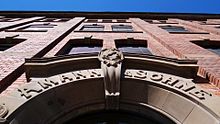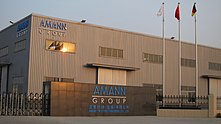Amann & Sons
| Amann & Sons GmbH & Co. KG
|
|
|---|---|
| legal form | GmbH & Co. KG |
| founding | 1854 |
| Seat | Bönnigheim , Germany |
| management |
|
| Number of employees | approx. 2500 |
| sales | approx. EUR 200 million |
| Branch | Textile industry |
| Website | www.amann.com |
| Status: 2019 | |
The Amann & Söhne GmbH & Co. KG is a leading provider of industrial, sewing and embroidery yarns . The company's headquarters are in Bönnigheim, Baden-Württemberg . In Germany, Amann is the market leader in the industrial sector, and Amann is one of the three largest producers worldwide. In 2019 the company reports a turnover of 200 million euros and 2,500 employees.
history
The company was founded in 1854 in Bönnigheim by Alois Amann and the Stuttgart businessman Imanuel Böhringer under the name Amann & Böhringer "for the purpose of manufacturing twisted and dyed silks."
The industrial age had not yet arrived in Bönnigheim at this point in time. At the beginning, the products were dyed in a dye works in Rau in Berg and then brought to Bönnigheim, where they were reworked by 12 twisters and reeled on a reel. The driving force was provided by two wheel drivers who laboriously turned a large flywheel. However, the strength of these men turned out to be insufficient until 1855 as a result of the other machines installed and their human performance was therefore replaced by a göpelwerk driven by two donkeys (later two oxen) . In 1856 four new twisting machines, six more wind machines and further winding and reeling machines were used. All engines were powered by a 4 horsepower steam engine, which replaced the ox.
The company quickly developed into a factory, which prompted the founders to invest in a steam engine with a steam boiler as well as other modern machines. In 1857 Amann & Böhringer employed around 100 people. With the establishment of his own black dyeing factory, Alois Amann became a pioneer in silk twisting in Germany.
In an industrial biography of Württemberg published in Leipzig in 1879, the company was described as follows: "The Amann & Söhne company is now considered the most important and efficient silk twining company in the whole of the German fatherland."
In 1880 the important competitor Payr & Mayer factory in Augsburg and its subsidiary in Mössingen were bought up and the management staff relocated to Bönnigheim.
Imanuel Böhringer left the company in 1882. Alois Amann converted this into a family business and integrated his sons Emil and Alfred as partners. As a result, he renamed the company Amann & Sons .
Emil Amann tried to manufacture synthetic fibers, but finally came to the conclusion that the natural silk could not be replaced by anything of the same value. In the 1880s the company expanded and opened two factories in the northern Italian towns of Seriate and Telgate . Emil Amann traveled to Germany and the most distant European countries to expand the sales of the factories, while his father and brother concentrated on running the company. In the following years Alfred Amann completed an apprenticeship as a dyer in Lyon, London and Krefeld and returned to Bönnigheim in 1888 to fill the post of technical director.
Alois Amann died in 1892 at the age of 68. From then on, his sons Emil and Alfred managed the company independently.
In 1902 the old Bönnigheim factory building was demolished in favor of a new building. The new building from 1902 is now a listed building and is still the company's headquarters.
As the original product, silk, was gradually being replaced by more modern raw materials, Alfred Amann began producing Schappeseide in 1919; in 1923 mercerized cotton was introduced. Emil Amann founded the first artificial silk factory at the time in Kelsterbach am Main in 1900. The United Kunstseidefabriken AG Frankfurt am Main developed from it, with additional facilities in Bobbingen near Augsburg, Spreitenbach and Glattbrugg (Switzerland).
Alfred Amann died in 1942 . Amann's son-in-law Alfred Pielenz was appointed as his successor. This led the company through the last years of the war, in which production came to a standstill, and through the post-war period, in which business operations were gradually rebuilt. In 1955 Amann & Sons pioneered the production of endless synthetic sewing threads.
In 1993/1994 Amann took over the Augsburg company Ackermann-Göggingen including its sewing thread dyeing plant. In addition, a fully automated industrial central warehouse was put into operation in Erligheim in 1996.
In 2002 the company expanded its product portfolio and launched new products for technical textiles.
In 2004 Hanns Pielenz, Alfred Pielenz's son, left the company after 36 years as managing director. Bodo Bölzle was appointed as his successor.
In 2006 the company opened a new production facility in Brasov, Romania . In 2008, Oxley Thread Ltd. one of the most famous sewing thread manufacturers in Europe. In 2009 Amann opened a new production facility in Yancheng . In 2013 the company expanded to Bangladesh and opened another new production facility in Mawna near the capital Dhaka . In 2016 AMANN opened its own research and development center with the AMANN Innovation Lab. In 2017, AMANN opened the Sewing Technology Center (STC), which is located at the company headquarters in Bönnigheim. In addition to the existing production facilities in Europe and Asia, a new 45,000 m² plant is being built in the Vietnamese coastal city of Đà N .ng. As of July 2019, sewing threads will mainly be produced there for the clothing and shoe industry.
Today AMANN has around 2,300 employees in more than 100 countries, including production sites, subsidiaries and sales partners. As of May 2018, the company management consists of Bodo Th. Bölzle (CEO) as well as Wolfgang Findeis (CFO) and Peter Morgalla (COO).
Products
The product range extends from classic sewing threads for the clothing industry to sewing threads for the automotive industry to special threads for technical applications.
Production facilities
The company's headquarters are in Bönnigheim / Erligheim.
- Bönnigheim (company headquarters)
- Erligheim (industrial central warehouse)
- Augsburg (production facility)
Amann produces exclusively in its own production facilities in:
- Manchester, UK
- Brasov, Romania
- Chribska, Czech Republic
- Yancheng, China
- Mawna, Bangladesh
In addition, Amann has its own branches in 21 countries and is present with commercial agencies in more than 100 countries.
Management / Amann family
Alois Amann (July 3, 1824 - September 28, 1892) founded the company together with Imanuel Böhringer (1822–1906) and managed it until his death.
Even before Alois Amann's death, his sons Emil (March 1, 1862 - January 30, 1935) and Alfred (September 20, 1863 - February 1, 1942) were involved as partners and later as sole managing directors. While Emil Amann retired from the company in 1917, Alfred Amann ran the company independently until his death in 1942. Alfred Amann in particular is still regarded as the decisive person in the company's history. He and his wife Jule were especially known in the local community as social sponsors and patrons. Today's Bönnigheimer Gymnasium, which was once founded by Amann, is called Alfred-Amann-Gymnasium. In addition, the Alfred-Amann-Weg is located in Bönnigheim, as well as other important buildings and facilities that were donated by Alfred Amann during his lifetime. Alois, Alfred and Emil Amann are honorary citizens of the city of Bönnigheim.
Alfred Amann's son-in-law, Alfred Pielenz (September 5, 1898 - July 12, 1989), ran the company from 1942 to 1968. He was replaced by his son Hanns A. Pielenz (November 22, 1939 - June 13, 2013), who handed over the position of managing director in 2004 to the current managing director, Bodo Th. Bölzle. Today the top management consists of Bodo Th. Bölzle, Wolfgang Findeis and Peter Morgalla.
literature
- Jörg Alexander Mann: The villa of the factory owner Alfred Amann in Bönnigheim: A country house in the chalet style as an example of the picturesque architecture in Württemberg at the turn of the 19th to the 20th century. Dissertation, Faculty of Architecture, University of Karlsruhe, 2007. S. 7ff. (PDF).
Web links
Individual evidence
- ↑ Archive link ( Memento of the original from June 24, 2015 in the Internet Archive ) Info: The archive link was inserted automatically and has not yet been checked. Please check the original and archive link according to the instructions and then remove this notice.
- ^ Josef Kurz, Kurt Sartorius, Werner Holbein, Dieter Gerlinger: The first 50 years of the Amann company . In: Stadt Bönnigheim (Hrsg.): The checkered history of a Ganerbestadt: Bönnigheim Hohenstein - Hofen . Bönnigheim 1984, p. 165 .
- ^ Elisabeth Zipperlen: Important personalities from Bönnigheim (II) - Alois, Emil and Alfred Amann . In: Zabergäuverein, headquarters Güglingen (Hrsg.): Heimatblätter from the Zabergäu . Zabergäuvereins magazine, issue 6, year 1982, 1982, p. 61 .
- ↑ Jörg Alexander Mann: The villa of the manufacturer Alfred Amann in Bönnigheim: A country house in the chalet style as an example of the picturesque architecture in Württemberg at the turn of the 19th to the 20th century . In: Faculty of Architecture, University of Karlsruhe (Ed.): Dissertation . Karlsruhe 2007, p. 7 .
- ↑ Hermann Brendle: A great Saulgauer - but unknown in his homeland. (No longer available online.) Schwäbische Zeitung, September 10, 2008, archived from the original on September 19, 2016 ; Retrieved July 4, 2016 . Info: The archive link was inserted automatically and has not yet been checked. Please check the original and archive link according to the instructions and then remove this notice.
- ↑ Bietigheimer Zeitung (ed.): Bönnigheim and its sewing threads - generations have worked in the sewing silk factories . Issue 261.Bietigheim-Bissingen November 10, 1979.
- ^ Bönnigheimer Zeitung (ed.): The life story of Herrrn Kommerzienrat Emil Amann . February 4, 2000, p. 16 .
- ↑ a b Josef Kurz et al .: The checkered history of a Ganerbestadt . 1984, p. 168 .
- ^ Josef Kurz et al .: The checkered history of a Ganerbestadt . 1984, p. 169 .
- ↑ Paul Wentz: My memories of the Amann company . In: Historical Society Bönnigheim eV (Hrsg.): Ganerbeblätter . 31st year 2008. Bönnigheim 2008, p. 3 ff .
- ↑ Amann & Söhne GmbH & Co. KG - company history. Ludwigsburger Kreiszeitung, August 14, 2014, accessed on July 6, 2016 .
- ↑ Amann Group: Sewing thread market leader increased its sales by 2.9% in 1996 to 360 million DM. (No longer available online.) TextilWirtschaft, March 27, 1997, archived from the original on July 4, 2016 ; Retrieved July 4, 2016 . Info: The archive link was inserted automatically and has not yet been checked. Please check the original and archive link according to the instructions and then remove this notice.
- ↑ Thomas Sümmerer: Megatrend integration. (No longer available online.) In: Edition 16. TextilWirtschaft, April 17, 2003, formerly in the original ; Retrieved July 6, 2016 . ( Page no longer available , search in web archives ) Info: The link was automatically marked as defective. Please check the link according to the instructions and then remove this notice.
- ↑ Amann takes over in England. Heilbronn Voice, accessed on February 12, 2008 .
- ↑ Tim Dörpmund: Function, but of course. (No longer available online.) In: Edition 24. TextilWirtschaft, June 11, 2009, formerly in the original ; Retrieved July 6, 2016 . ( Page no longer available , search in web archives ) Info: The link was automatically marked as defective. Please check the link according to the instructions and then remove this notice.
- ^ Jürgen Kunz: On the death of Hanns A. Pielenz: A citizen of the world with roots in Bönnigheim. Bietigheimer Zeitung, June 15, 2013, accessed on July 4, 2016 .
Coordinates: 49 ° 2 ′ 20 " N , 9 ° 5 ′ 38.4" E




